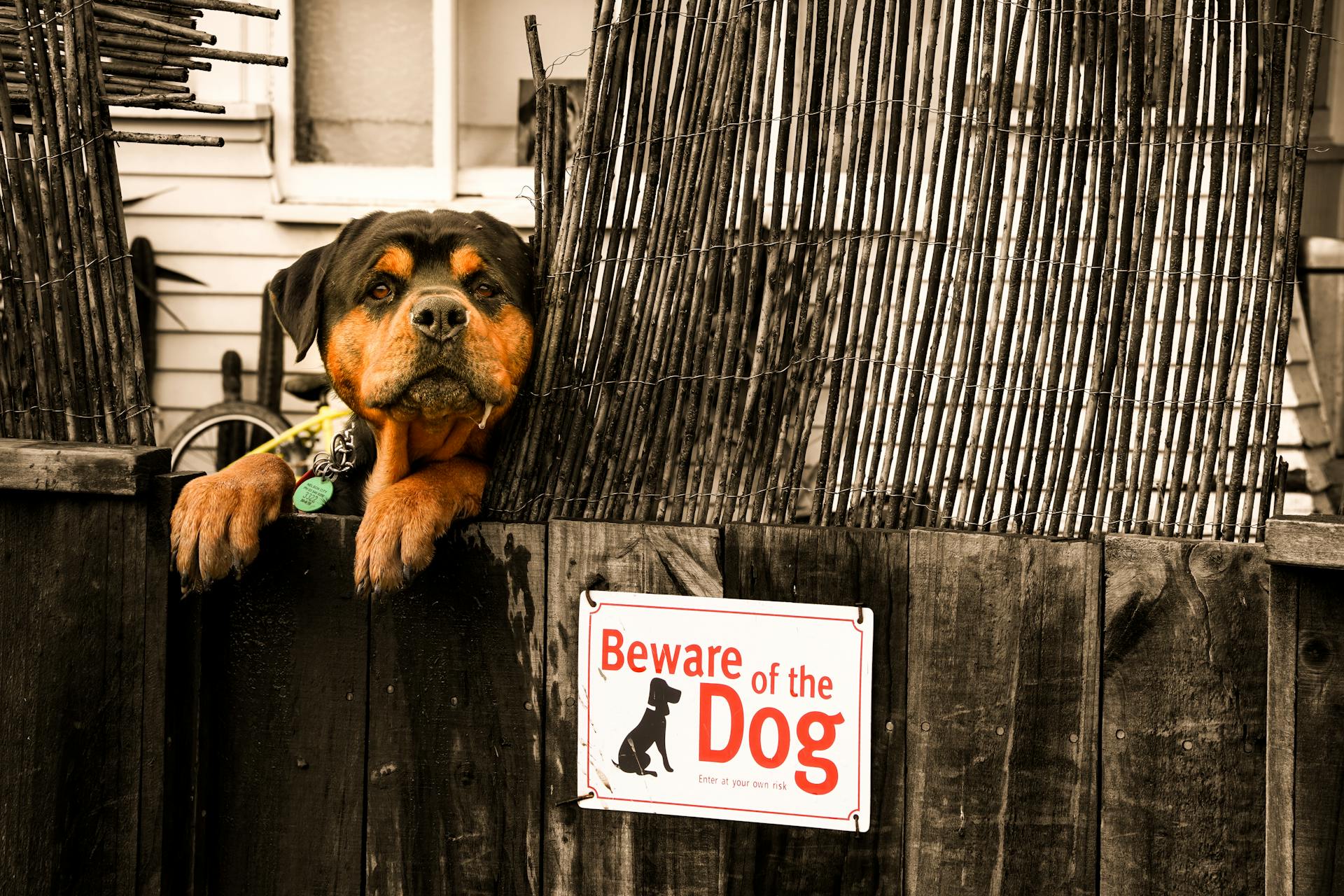
Rottie tail docking, a practice that sparks debate among dog owners and breeders. The decision to dock a Rottweiler's tail is often based on cosmetic reasons, with some breeders believing it improves the dog's appearance.
However, tail docking is also performed for health reasons. According to some breeders, a docked tail can reduce the risk of tail injuries and infections.
But, the American Veterinary Medical Association (AVMA) does not support tail docking for non-therapeutic reasons. The AVMA states that tail docking is a surgical procedure that can cause pain and complications.
Some breeders argue that tail docking is a tradition that has been passed down through generations, but this argument may not hold up to scrutiny.
Recommended read: Boxer Dog Tail Docking
Reasons for and Against Tail Docking
Rottweilers with docked tails are often seen as more streamlined and balanced, but this is a misconception. In reality, a Rottweiler's tail helps with balance and communication, and docking it can have adverse effects on their hips and elbows.
The idea that docked tails make Rottweilers faster or more balanced is just propaganda. There is no scientific basis for this claim.
Some people believe that docking a Rottweiler's tail is necessary for working dogs, but this is not the case. In fact, many countries have banned the practice, and even the American Veterinary Medical Association has taken a stance against it.
The main reasons for docking a Rottweiler's tail are functionality and showing purposes, but these are outdated and unnecessary. Today, most Rottweilers do not work as working dogs, and their tails are docked solely for aesthetic reasons.
Here are some countries that have banned tail docking:
- The Netherlands
- Germany
- Norway
- Turkey
- Almost 40 countries in total
The Rottweiler Club of North America has also banned the practice, and many veterinarians refuse to perform the procedure. It's time to rethink our approach to tail docking and give Rottweilers the chance to keep their natural tails.
Reasons Became Cosmetic
The reasons for docking Rottweiler tails have shifted over time, and today they're more about appearance than practicality.
The American Kennel Club (AKC) has made tail docking a part of their breed standard, which means many people who want to show their dogs have to comply with this standard.
In fact, the AKC Rottweiler breed standard specifically states that the tail should be docked short, close to the body, leaving one or two tail vertebrae.
The AKC's influence has made tail docking a popular tradition in the United States.
However, it's worth noting that many countries have banned tail docking altogether, with over 40 countries having laws against it.
In Germany, where Rottweilers originated, tail docking is illegal and Rottweilers are required to have natural tails to be in compliance with ADRK and FCI rules.
Despite the lack of practical benefits, some people still believe that docked tails make their Rottweilers look scarier or more intimidating.
Studies have shown that dogs with cropped ears and docked tails are perceived as being more aggressive and less friendly than natural dogs.
Curious to learn more? Check out: Are Rottweilers Born with Tails
Reasons for and Against Tail Docking
In the past, Rottweilers were docked for a variety of reasons, including to prevent injuries during hunting expeditions. However, studies have shown that Rottweilers with docked tails have less injuries than those with long tails, but only in working-type dogs.
Historically, Rottweilers' tails were docked because they pulled meat carts to markets, and it was believed the tail got in the way. However, the real reason is simply because it makes the dog look scarier.
Many breeders and owners dock Rottweilers' tails to make them look more intimidating, which is a major reason for the practice. In fact, studies have shown that dogs with cropped ears and docked tails are perceived as being more aggressive and dominant.
Rottweilers may have had their tails docked as far back as ancient Rome, where it was believed that cutting off a dog's tail and tongue prevented rabies. Unfortunately, docking Rottweilers' tails also became common in dogfighting, where the dogs were trained to be aggressive and forced to fight against other dogs.
A different take: Breeds of Dogs with Docked Tails
Here are some of the main reasons for and against tail docking:
The American Kennel Club (AKC) has a breed standard that requires Rottweilers to have a docked tail, but many countries have made it illegal due to animal welfare concerns. In fact, almost 40 countries have restricted or outright banned the practice.
Why is Unnecessary
Tail docking is a practice that's been debated for a long time. It's unnecessary because docking a Rottweiler's tail does not actually help them in any way. The breed is no longer used for physical labor tasks, so there's no practical need for tail docking.
Many people believe that tail docking helps with a Rottweiler's balance, but the truth is, their tail is a functional limb that helps their equilibrium when running or performing activities. In fact, the tail is a crucial part of a dog's body language, allowing them to communicate friendliness, aggression, dominance, submission, excitement, or nervousness.
Worth a look: Dog Tail Docking Problems
The procedure of tail docking is painful to puppies, regardless of their age. Puppies are extremely vulnerable in the first week of life, and having them surgically lose a limb is a very extreme experience.
Here are some key points to consider:
- Docking a Rottweiler's tail is unnecessary because it doesn't help with their physical labor tasks.
- The procedure is painful to puppies, regardless of their age.
- The tail is a functional limb that helps with a Rottweiler's balance and equilibrium.
- The tail is a crucial part of a dog's body language, allowing them to communicate their emotions and intentions.
History and Regulation of Tail Docking
Tail docking has a long and complex history, with various reasons cited for its practice. The procedure has been banned in almost 40 countries, including Germany, where it originated.
Historical reasons for tail docking include preventing rabies, as the Romans believed cutting off a dog's tail and tongue prevented the disease. Some owners of working dogs also docked their tails to prevent injuries, as it was believed the tail was prone to damage.
The American Veterinary Medical Association does not approve of tail docking, and most veterinarians refuse to perform the procedure. In the United States, tail docking is still mostly legal, but there are restrictions in Maryland and Pennsylvania.
The reasons for tail docking have shifted over time, with cosmetic factors becoming more prominent. According to the American Kennel Club, Rottweilers are required to have a docked tail to meet breed standards for shows and competitions.
Expand your knowledge: Schnauzer Tail Docking
History and Regulation of Tail Docking
Tail docking has been a topic of debate for many years, and its history is quite fascinating. Tail docking is banned in almost 40 countries.
The practice of tail docking originated in Germany, where it was once a common practice. In Germany, the German Rottweiler has to have a natural tail to be in compliance with ADRK and FCI rules.
The American Veterinary Medical Association does not approve tail docking. Most veterinarians refuse to perform the procedure, considering it painful and unnecessary for dogs.
Tail docking is still mostly legal in the United States, but there are restrictions on it in Maryland and Pennsylvania. Many vets refuse to perform the procedure.
There are nearly 40 countries that have banned tail docking entirely. The Rottweiler Club of North America has also banned the practice.
The German ADRK and the FCI Breed Standard have changed to require natural tails on Rottweilers. The American Veterinary Medical Association has taken a stance against tail docking.
The procedure of docking a Rottweiler's tail can be done in a couple of ways, but the safest way is with a veterinarian. Typically, it's done when the puppy is a few days old.
Curious to learn more? Check out: Tracheal Collapse Natural Treatment
Historical Reasons Docked
Tail docking has been a practice for thousands of years, with evidence suggesting it was done as far back as ancient Rome. Rottweilers were used by the Romans to prevent rabies, and their tails were cut off as part of this practice.
In the past, Rottweilers were docked for various reasons. One reason was to prevent injuries to the tail while working in physically intense environments. This was a common practice among working dogs, including hunting dogs.
Unfortunately, docking Rottweiler tails also became common in dogfighting, where these dogs were trained to be aggressive and forced to fight against other dogs for sport. Dogs engaged in dogfighting needed shorter tails to reduce their weak spots against the other dogs.
Here are some of the historical reasons why Rottweiler tails were docked:
- Rabies prevention in ancient Rome
- Prevention of tail injuries in working dogs
- Reduction of weak spots in dogfighting
These reasons may seem outdated, but they highlight the complex history behind tail docking.
Concerns and Controversy
There are many concerns and controversies surrounding Rottweiler tail docking. It's legal in America but restricted or banned in almost 40 countries, which should give us pause.
Many countries have actually banned the practice of clipping or docking the tail of Rottweilers and other dogs. The Netherlands, Germany, Norway, and Turkey have all banned the practice.
The American Veterinary Medical Association has taken a stance against the practice, leading many veterinarians to refuse to perform the procedure. This is a significant shift in the veterinary community.
The Rottweiler Club of North America has also banned tail docking, requiring natural tails for dogs born after January 1, 2019, to participate in their events. This change follows the FCI Breed Standard.
Concerns about a Dog
A Rottweiler's natural tail is usually hanging while at rest and over the back when the dog is excited. This is perfectly normal and doesn't indicate anything wrong with the dog.
Today, most dogs are pets, companions, and service dogs rather than working dogs. This shift in purpose has led to a decrease in the need for certain physical characteristics, such as docked tails.
A Rottweiler with a docked tail is just as lovable and loyal as one with a natural tail. In fact, the breed is known for being a beautiful dog, with or without their tails.
To Sum Up the Controversy

The Rottweiler tail docking controversy is a complex issue, but let's break it down to the basics. In America, it's still legal to dock a Rottweiler's tail, but in almost 40 countries, it's restricted or banned.
Many veterinarians refuse to perform the procedure, and those who do often charge a high price. This has led some breeders to attempt to dock a Rottweiler's tail themselves, which can be even more painful for the dog.
Docking a Rottweiler's tail is generally done when the puppy is just a few days old, when the nervous system is still developing. However, the procedure still hurts, and many veterinarians now refuse to do it.
The American Veterinary Medical Association has taken a stance against tail docking, and many veterinarians have followed suit. This has reduced the popularity of the practice worldwide.
In many countries, including the Netherlands, Germany, Norway, and Turkey, tail docking is completely banned. This means that if you're looking to buy a Rottweiler from a breeder in one of these countries, you can be sure the dog has a natural tail.

The Rottweiler Club of North America has also banned tail docking, requiring dogs born after January 1, 2019, to have a natural tail to compete in events. This is in line with the FCI Breed Standard.
It's worth noting that some breeders and owners still support tail docking, often citing its supposed benefits for working dogs. However, this is a minority view, and many experts agree that the practice is unnecessary and cruel.
Opposition to Docking
Opposition to docking is growing globally, with nearly 40 countries banning the practice.
Many countries, including Germany, the Netherlands, Norway, and Turkey, have outright banned tail docking.
The American Veterinary Medical Association does not approve of tail docking.
The Rottweiler Club of North America has banned the practice, requiring natural tails for dogs born after January 1, 2019.
The German ADRK has also changed its standard to require natural tails for Rottweilers.
Even the American Veterinary Medical Association has taken a stance against tail docking, leading many veterinarians to refuse to perform the procedure.

In fact, some veterinarians consider tail docking cruel, especially when performed on puppies as young as a few days old.
Most of the veterinarians refuse to perform the procedure, considering it painful and unnecessary for the dog.
Many individuals have turned away from tail docking, joining the growing opposition to the practice.
Frequently Asked Questions
Are all Rottweilers born with long tails?
No, not all Rottweilers are born with long tails. The gene responsible for long tails, c189g, is not present in most Rottweilers due to selective breeding
Why dock dog tails?
Tail docking is often done to conform to a breed's appearance or standard, rather than for health reasons. However, survey data suggest that it's unnecessary for pet dogs.
Does tail docking hurt?
Yes, tail docking is a painful procedure. It involves cutting or removing a portion of a dog's tail, which can cause immediate and potentially long-term pain.
Can Rottweilers be born with bob tails?
Yes, Rottweilers can be born with bob tails, but this is not a natural inherited trait. Instead, it's often the result of a genetic mutation that causes a shortened or missing tail.
What does it mean when a Rottweilers tail is up?
When a Rottweiler's tail is carried straight out from its body, it indicates confidence and a willingness to defend itself if necessary
Sources
- https://mississippirottweilers.com/rottweiler-tails-to-dock-or-not-to-dock/
- https://www.dogster.com/dog-breeds/rottweiler-tail-docking
- https://www.4rottweilers.com/rottweiler_natural_tail.htm
- https://www.a-love-of-rottweilers.com/why-are-rottweilers-tails-docked.html
- https://redrover.org/2022/09/09/eye-of-the-rottweiler-roxies-happy-tail/
Featured Images: pexels.com

